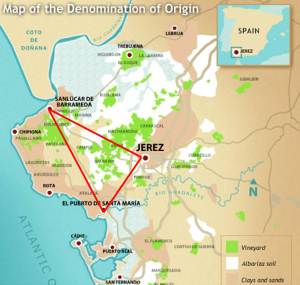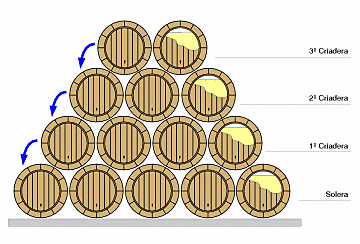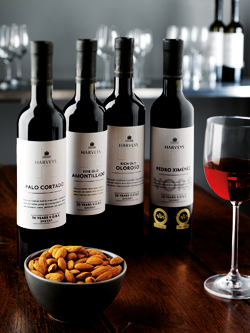Sherry is a category that BarLifeUK has long wanted to learn more about and earlier this week we had a chance thanks to a Harveys Training Session.
Over the last couple of years Sherry has been become more prevalent in cocktail competitions and on cocktail lists in the UK. In the States this trend is even greater with New York and San Francisco especially leading the way.
However knowledge of this category in this country is probably not as high as it should be. Maxxium’s Mixxit team and their sherry brand Harveys want to change that and held the first of what we hope will be many masterclasses.

The talk was led by Harveys Brand Ambassador Maria Eugenia Herrera Garcia whose knowledge and passion for the sherry category as a whole was infectious. Before we got down to some very enjoyable sherry tasting with food matches the group were given a look at the sherry category as a whole.
Sherry Production
Vines were first introduced into the Andalucia region of Spain, the home of sherry, more than 3,000 years ago. Since that time there have been many cultures that have called it home, from Greeks to Romans, Carthaginians to Christians, the one thing they have all had in common is a love of wine production.
One of many things they disagreed on was the naming of the municipality of what we now know as Jerez. It is it’s name in around the 8th Century that it most important to us, when it was known as Sheris (later changed to Sherris in the 16th Century), which would give us the name of the local wine – sherry.
Sherry production has been protected by a Denominación de Origen since 1933. One of those rules states that sherry has to be produced and aged in what is known as the ‘Sherry Triangle’ demarcated by the towns of Jerez, Sanlucar and El Puerto de Santa Maria (the grapes can be grown outside this area).
The area is perfect for growing the type of grapes needed to produce sherry. Located close to the sea and two major rivers it has on average 300 days of sun but still 620 litres per square metre of rain. It also has two distinct winds which all combine to produce fantastic grapes.
Grape Excitement
There are three types of grapes which can be used in the production of sherry:
- Palomino grapes are grown in the areas famous while soil, ‘albariza’ and are used to produce dry sherries.
- Pedro Ximenez (PX) grapes are grown closer to the coast and are used in sweet sherry production.
- Muscatel grapes are the least used of the three (Harveys don’t grow or use any in their range) but are used in a similar fashion to PX.
These grapes aren’t just grown differently but are handled very differently once picked.
Palomino grapes are taken straight from the vines and immediately pressed and classified into different levels of must before fermentation. Whereas the PX (and if used Muscatel) grapes are traditionally picked slightly later in the season before being laid out in the sun for a couple of days to increase the sugar content and therefore sweetness.

The Palomino must is then put into stainless steel vats to ferment for a couple of months to produce a base wine of around 11-12% ABV. It’s at this point the Palomino base wine gets interesting and a very distinctive method is used.
When the base wine is added to old American Oak barrels to age natural local yeasts produce what is known as a ‘flor’ on the top of the liquid. This flor is a layer of yeast which protects the liquid from oxidation, allowing what is known as Biological Aging.
This yeast also has to live, to do this it needs air which is provided by not filling the barrels to the rim, and food. For it’s food it lives on the sugars present in the wine which is how fino sherry gets it’s unique dryness.
In contrast the PX grapes are used to make what are known as Natural Sweet Wines using Oxidative Aging which simply put uses no flor and a more traditional ageing process.
Solera So Good
The ageing process used is the Solera system which rum fans will be very familiar with. This system, in it’s most basic form, relies on older barrels being regularly topped up from younger barrels.

Imagine you produced a base wine in year one and put it in a barrel. Year two you produce another base wine from the same grapes and put that in another barrel. By year three you wanted to start selling something but instead of using the whole of the year one barrel you used a third of it and sold that.
You then took a third of the year two barrel and topped up the year one barrel. You then took the latest harvest and topped up the year two barrel with that one. You keep doing this every year.
Now imagine that on a much bigger level and done by hugely skilled individuals and you get a rough idea of the Solera System. Oh and to be a sherry it has to be aged for a minimum of 3 years.
Whilst they are busy doing that they are also tasting all of the barrels and deciding whether they should be Fino or Oloroso. If they are deemed to be Oloroso then the Biological Aging (with our friend flor) needs to be stopped.
This is surprisingly easy. As you know sherry is a fortified wine which means the ABV needs to be increased. As it turns out yeast can’t survive over 16% ABV. So the Oloroso sherrys are increased to 17% to kill the yeast and the Fino only increased to 15% so the flor can keep doing it’s thing.
This Is The Blend
So we have the dry styles of sherry using the Palomino grape and the natural sweet wines using the PX grapes but there is a third type. Blended.
You won’t be shocked to hear that blended sherries are a blend of other types of sherry. This is a whole other world that we don’t have time to go into here but hopefully as this sherry trend keeps gaining momentum we will bring you more in depth articles.
It should also be pointed out this is a very basic look at the production of sherry and we are sure there will be those with large knowledge desperate to add to it. What we hope this has done is get those of you less familiar with this key cocktail ingredient a little more clued up and keen to learn more.
As we said we will be bringing you more but in the meantime let us tell you quickly about the Herveys range we were lucky enough to try.
Harveys Range
We started off with the Harveys Fino which contains no sugar and comes in at 15%. This was possibly our favourite of the day and reminded us how good a glass of sherry can be at any time of the day (it was after midday we can assure you).
We moved onto the Harveys Medium Dry, a blended sherry (92% Palamino grape and 8% PX) coming in at 17.5%. Medium Dry sherries have never been our favourite but this one seemed to slip down pretty well.
The companies new expression was next up, Harveys Signatureis billed as a rare cream sherry (80% Palamino and 20% PX) with an average age in the bottle of 12 years and 19% ABV. If, like us, cream sherry brings back strange Christmas memories involving your nan then we are here to tell you this is a different beast. It is a superb product and when served with the strong cheese we had with it…. well we may have asked for a second glass.

Then came the companies best known product and the best selling sherry in the world, Harveys Bristol Cream. As with a lot of products in this industry that are the worlds best selling, this can be an issue for bartenders. When it has such strong childhood memories it makes it even harder.
However with the barriers down and a couple of glasses already in us it quickly became obvious we had been unfairly cruel to this product over the years. Sure, we personally preferred the Fino and Signature but we urge you not to dismiss it and give it an honest go.
We then got introduced to the Harveys Super Premium Range, known as VORS (Very Old Rare Sherries). To be considered a VORS sherry an independent group come and blind taste the products to see whether they are good enough to be included and carbon dating technology is used to ensure the minimum 30 year old age range is hit.
VORS sherries can also only be Oloro Rosso, Pedro Ximenez, Palo Cortado and Amontillado.
These sherries have between them have won awards all around the world and are highly regarded by those in the know. We must admit that a couple of them were a bit over our heads (in actual fact we thought one was off when we first tasted it) and we may need to build up our pallet to get to the point we can truly appreciate them, an undertaking we are more than happy to take.
In saying that we really enjoyed a couple of them and one in particular nearly ‘accidentally’ fell into our bag on the way out. We won’t tell you which our favourites were so you can go in with an open mind but we tried.
Harveys Fine Old Amontillado VORS which is 100% Palomino grapes, 19% ABV and a solera foundation of 1914.
Harveys Medium VORS Very Old Palo Cortado Blend which consists of 98% Palomino grapes and 2% PX, 19% ABV and a solera foundation of 1906.
Harveys Medium VORS Very Old Oloroso Blend with 90% Palomino and 10% PX, 20% ABV and a solera foundation of 1909.
Harveys Pedro Ximenez Blend with 100% PX, 16% ABV and a solera foundation of 1919.
We must give big thanks to Charles and his team 5cc Cocktail Club at Harrild & Sons for their hospitality and fantastic food matching. Also to Harveys and Mixxit for such a great session.
We will be bringing you news of a Harveys Cocktail Competition next week and after this session we can’t wait to see what you have in store for us.

